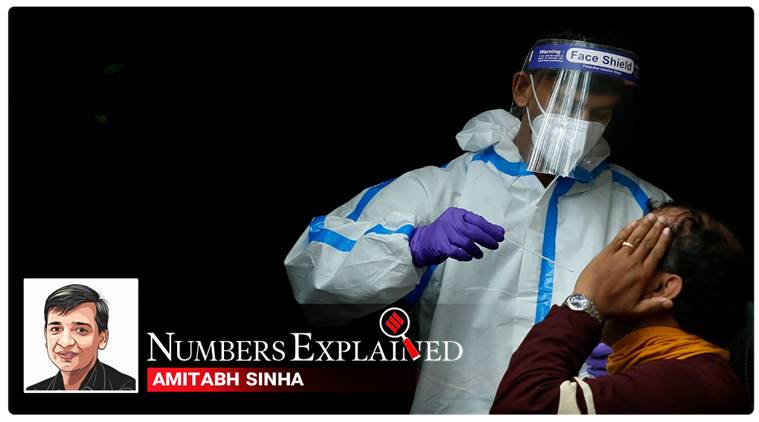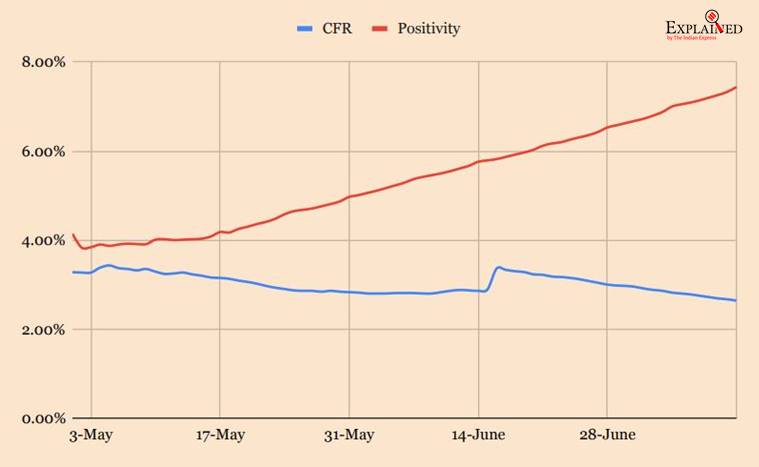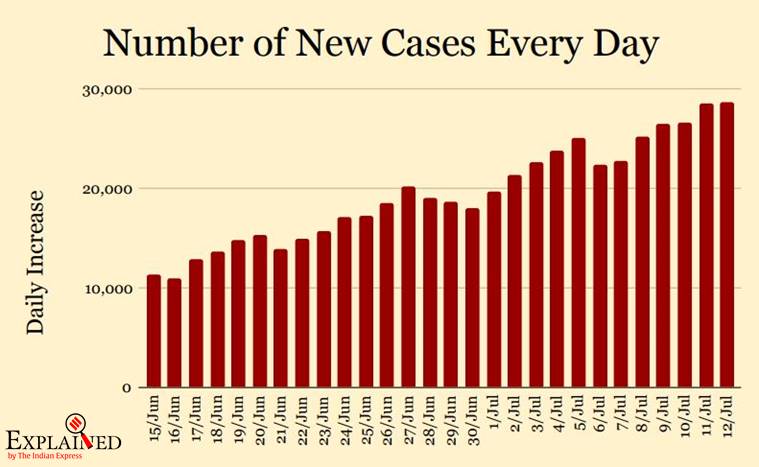
[ad_1]
 Health workers at a covid19 test center in New Delhi (Express photo/Praveen Khanna)
Health workers at a covid19 test center in New Delhi (Express photo/Praveen Khanna)
India Coronavirus Cases Numbers: There are two trends in the novel Coronavirus pandemic in India that have remained almost unchanged in the last over two months — an increasing positivity rate and a declining the death rate.
The positivity rate is the number of people found to be infected with the virus from among those who are being tested. It is an indicator of how widespread the disease in any region is. At the beginning of May, the positivity rate in India was 4.14 per cent, meaning out of every 10,000 individuals who were being tested, 414 were testing positive. This has slowly increased over time and is 7.44 per cent now. That means that out of those who are being tested, far more number of people are turning out to be positive.
The death rate, also referred to as the case fatality ratio, is the ratio of number of people who have died against those who have tested positive. This is an indicator of how well the country is doing in averting deaths. The death rate in India at the beginning of May was 3.28 per cent. This has declined progressively and is now at 2.64 per cent. It means that the record in avoiding deaths due to the disease is slowly improving.
 As of now, the positivity rate is likely to keep on increasing for some more time.
As of now, the positivity rate is likely to keep on increasing for some more time.
An increasing positivity rate indicates that the presence of the disease in the community is fairly widespread, and is probably getting transmitted at a fast pace. But it is arising from the fact that the testing is still restrictive. Since it is not possible to test everyone, health authorities devise criteria on who needs to be tested first.
As of now, most states, due to constraints on their capacities, have restrictive criteria to test people. Only those showing symptoms, or those who are primary contacts of already infected people, are being tested in many states. These target groups have a higher probability of turning out to be positive, compared to a random person. It is possible that if the tests are done randomly, the positivity rate would be much lower. but then that process would miss out on some high-risk individuals. As of now, the positivity rate is likely to keep on increasing for some more time.
📣 Express Explained is now on Telegram. Click here to join our channel (@ieexplained) and stay updated with the latest
 For the second successive day on Sunday, the number of new cases exceeded 28,000.
For the second successive day on Sunday, the number of new cases exceeded 28,000.
The decline in the death rate is also something that is expected to continue, probably for longer time. This, despite the fact that the number of deaths being reported every day is steadily climbing up. On Sunday, for example, 500 deaths were reported, more than any previous day. The only time the death rate showed an increase in the last two months is when Maharashtra added more than 2,000 deaths in a day in a data reconciliation exercise, bunching together hundreds of previously unreported deaths from the last several days.
Scientists believe that by the time this epidemic comes to an end, and they are able to make more reliable estimates of the extent of the spread of the disease, not just through testing, but by using other sampling methods as well, the death rate should be below one per cent.
Meanwhile, the number of people being found infected every day is rising steadily. For the second successive day on Sunday, the number of new cases exceeded 28,000. India now has 8.78 lakh confirmed infections, out of which over 5.53 lakh have already recovered from the disease. But the number of active cases is also increasing, and on Sunday this number crossed the 3-lakh figure mark.
Top ten states with maximum caseload
| STATE | TOTAL POSITIVE | NEW CASES | TOTAL RECOVERIES | DEATHS
|
| Maharashtra | 254,427 | 7,827 | 140,325 | 10,289 |
| Tamil Nadu | 138,470 | 4,244 | 89,532 | 1,966 |
| Delhi | 112,494 | 1,573 | 89,968 | 3,371 |
| Gujarat | 41,897 | 871 | 29,189 | 2,047 |
| Karnataka | 38,843 | 2,627 | 15,409 | 688 |
| Uttar Pradesh | 36,476 | 1,384 | 23,334 | 934 |
| Telangana | 34,671 | 1,269 | 22,482 | 356 |
| West Bengal | 30,013 | 1,560 | 18,581 | 932 |
| Andhra Pradesh | 29,168 | 1,933 | 15,412 | 328 |
| Rajasthan | 24,275 | 644 | 17,990 | 510 |
Eight of the ten states with highest caseloads in the country are now adding more than 1,000 new cases every day. Out of these Maharashtra has been reporting more than 7,000 cases every day, while Tamil Nadu is adding about 4,000. Gujarat and Rajasthan are the two exceptions. On Sunday, even Bihar reported more than 1,200 cases.
📣 The Indian Express is now on Telegram. Click here to join our channel (@indianexpress) and stay updated with the latest headlines
For all the latest Explained News, download Indian Express App.
© IE Online Media Services Pvt Ltd
[ad_2]
Source link